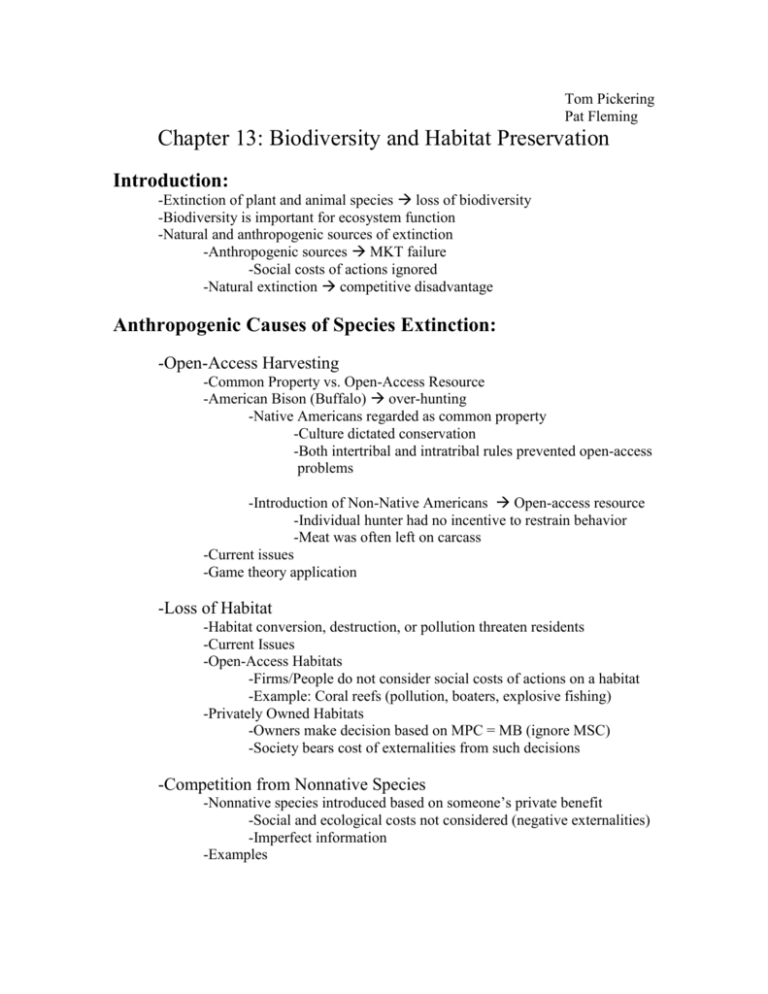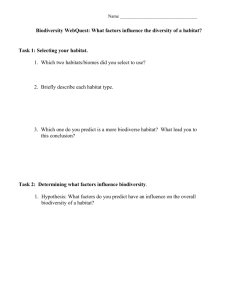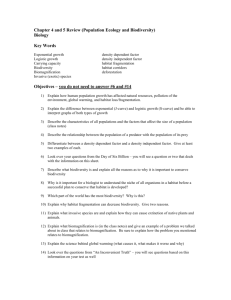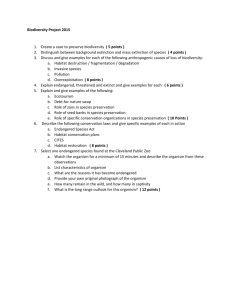Chapter 13: Biodiversity and Habitat Preservation
advertisement

Tom Pickering Pat Fleming Chapter 13: Biodiversity and Habitat Preservation Introduction: -Extinction of plant and animal species loss of biodiversity -Biodiversity is important for ecosystem function -Natural and anthropogenic sources of extinction -Anthropogenic sources MKT failure -Social costs of actions ignored -Natural extinction competitive disadvantage Anthropogenic Causes of Species Extinction: -Open-Access Harvesting -Common Property vs. Open-Access Resource -American Bison (Buffalo) over-hunting -Native Americans regarded as common property -Culture dictated conservation -Both intertribal and intratribal rules prevented open-access problems -Introduction of Non-Native Americans Open-access resource -Individual hunter had no incentive to restrain behavior -Meat was often left on carcass -Current issues -Game theory application -Loss of Habitat -Habitat conversion, destruction, or pollution threaten residents -Current Issues -Open-Access Habitats -Firms/People do not consider social costs of actions on a habitat -Example: Coral reefs (pollution, boaters, explosive fishing) -Privately Owned Habitats -Owners make decision based on MPC = MB (ignore MSC) -Society bears cost of externalities from such decisions -Competition from Nonnative Species -Nonnative species introduced based on someone’s private benefit -Social and ecological costs not considered (negative externalities) -Imperfect information -Examples Importance of Biodiversity -Stability (i.e. Genetic Variation) -Diversity helps ecosystems to manage shocks and stresses -Promotes overall health and function -Protection of freshwater supplies -Absorption of carbon dioxide -Nutrient cycling -Provision of habitat -Economic Value -Healthy plants and animals have economic value (medicines, natural chemicals and compounds) -Genetic Information -Genetic engineering -Personal Utility from Biodiversity -Intrinsic value Costs of Losses of Habitat -Individual benefits of habitats listed in other chapters -Generally, provide environment for healthy plants and animals -Example: Wetlands -Nutrient cycling -Origin of aquatic food webs -Buffer against storms / Lessen effects of droughts (sponge) -Rare species Policies for Maintaining Biodiversity -Policy Focus -Commercial Benefits of Biodiversity -Non-market benefits -Policies to Reduce Open-Access Exploitation -Assign property rights -Owners have incentive to preserve a resource (like an elephant) -Property rights assignment is sometimes unpopular -Fish and game resources in the U.S. -Certain rules on when, how, and what can be hunted with penalties -If demand is inelastic enough, supply side restrictions can fail - Needs to be combined with demand intervention -Policies to Reduce Competition from Nonnative Species -Command and Control -Liability system not always practical -Permits -Ban species introduction -Policies to Reduce Loss of Habitat -Traditional MPC not equal to MSC problem * -Incentive -Suggested Solution: Royalties for medicinal discoveries -Internalizes cost of loss of habitat -Does not deal with other public good benefits of preservation -Internationalized system of marketable carbon permits forest preservation -Make costly to not preserve or give benefits to preserve? -Equity question -Command and Control -Difficulty in incorporating all values of habitat preservation into private costs and benefits -Policy -NGO’s buy land for preservation -Public goods usually will not be privately provided -Private landowner cannot capture benefits -Free rider problem prevents individuals from paying -Reduces transaction costs -Command and Control -Create protected areas -Restrict use of privately owned lands -How do you define land? -Endangered Species Act of 1973 -No federal funds used in projects that might endanger species -Focus on species my not be best way to protect (snail darter) -Reactive Policy








